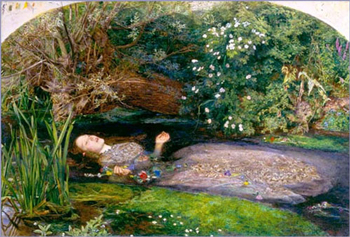| Search Art Prints | ||||||||||||||||||||
| Search Artists | ||||||||||||||||||||

|
||||||||||||||||||||
|
|
|||||||||||||||||||

Ophelia

|
John Everett Millais’s vibrant, detailed rendering of Ophelia’s death was shown at the Royal Academy exhibition in 1852. It is one of his best known and admired pictures. It is called Ophelia.
Dozens of flowers are depicted in Ophelia. Millais did carefully select and paint his flowers so that most are identifiable. There are violets, poppies, pansies, willows and many more and some of them have a symbolic meaning. Take for instance, pansies; they signify love in vain or thought, poppies signify sleep or death, violets, death in youth and daisies, innocence. Some of the flowers Millais includes are referred to Act IV, scene of Shakespeare’s tragedy in which Ophelia recites the names of flowers she had been gathering.
To understand the painting, one must know its origins. John Everett Millais Ophelia was taken from Hamlet, a tragedy written in 1599-1601 by William Shakespeare. The story is as follows:
Hamlet, prince of Denmark, returned from the University after learning of his father’s death. Upon arrival, he found his Uncle Claudius (his father’s brother) had married his widowed mother, Queen Gertrude and became King. The ghost of his father came to Hamlet and asked him to avenge his death for he had been poisoned by his brother. Hamlet started to act. He made believe he was mad and even disowned his beloved wife Ophelia. While Ophelia’s Father was spying on Hamlet in his mother’s chamber; Hamlet thinking that it was Claudius, killed him. Ophelia went crazy and drowned herself. In the end, everyone dies.
The painting Ophelia was severely criticized by most reviewers but for us, it is one of Millais’s finest works of art.
The 1852 pencil sketch is owned by the Birmingham Museum and Art Gallery.











